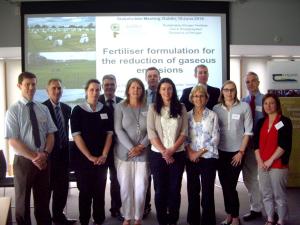Research undertaken by both Teagasc and the Agri-Food and Biosciences Institute (AFBI) has highlighted practical ways for agriculture to reduce greenhouse gas emissions, maintain production and save farmers money.

Scientists from Teagasc and AFBI presented key results from a multi-site and multi-year experimental field trial that focussed on both grassland and spring barley. These trials evaluated the effects of fertiliser formulation and organic manures on the potent greenhouse gas nitrous oxide (N2O) and on the air pollutant ammonia (NH3). Recently published results were presented to stakeholders from the farming industry, fertiliser industry and government policymakers at a meeting in Teagasc National Botanic Gardens on Friday 10th June.
The SUDEN/AGRI-I projects are funded by the Department of Agriculture, Food and the Marine (RSF 10/RD/SC/716 and 11/S/138) and the Department of Agriculture, Environment and Rural Affairs in Northern Ireland (AFBI, E&I 13/4/06). The experimental trial sites included Johnstown Castle, Co Wexford (Teagasc), Moorepark, Co Cork (Teagasc) and Hillsborough, Co Down (AFBI).
Striking a Balance
EU member states have committed to reduce their overall greenhouse gas (GHG) emissions by 20% by 2020 and to reduce emissions of the air pollutant ammonia. Simultaneously, ambitious agricultural production targets have been set both North and South in response to the increased demands for food and abolition of EU milk quotas (Going for Growth 2020; Food Wise 2025). In order to achieve these targets, the farming industry is facing increasing pressure to simultaneously increase yields, to improve nitrogen (N) use efficiency whilst reducing emissions of the potent GHG N2O and ammonia. These emissions are associated with the application of mineral and organic N fertilisers.
Teagasc and AFBI have collaborated for the last 3 years to investigate agricultural N2O emissions and ways to reconcile both production and environmental targets. Dr. Rachael Carolan, Agri-Food & Biosciences Institute, Northern Ireland said “The project highlighted that greenhouse gas emissions associated with dung and urine excreta deposited by grazing animals were 85 and 41% lower respectively compared to the international factor used for national GHG reporting’. The implications of this are that nitrogen fertilisers are the main source of N2O emissions from Irish agriculture.
The project further investigated ways to reduce GHG emissions from fertiliser. The form of N fertiliser used can have a major impact on the magnitude of GHG emissions. CAN is currently the most widely used straight fertiliser N source in Ireland. Dr Patrick Forrestal Teagasc Johnstown Castle said “The project found that switching from CAN to urea with the urease inhibitor N-(n-butyl) thiophosphoric triamide (NBPT) reduced direct GHG emissions associated with fertiliser application by 73% on average in grassland. Treating urea fertiliser with NBPT also reduced ammonia losses by up to 78.5%.”
Dr Catherine Watson, Head of Agri-Environment Branch in AFBI chaired the event and said "the findings presented today are the culmination of research completed over many years by the team that I lead at AFBI, and the close cooperation we have had with the Teagasc team at Johnstown Castle. The findings validate the economic and environmental benefits that the widespread adoption of stabilised nitrogen would realise for the agricultural sector. These benefits also provide a sustainable platform for the export growth ambitions as set out in the multi-stakeholder 'Going for Growth' programme."
Dr Karl Richards of Teagasc summarised the event by saying “This exciting research has highlighted that switching from CAN to urea treated with NBPT saves the farmer money, while simultaneously maintaining yields and nitrogen use efficiency and reducing greenhouse gas emissions.”
Results from these multi-site and multi-year Irish field trials show that:
- Fertiliser nitrogen is the main source of the potent Greenhouse gas N2O on Irish farms.
- Averaged over all grassland sites, switching from CAN to NBPT treated urea reduced direct emissions of the Greenhouse gas N2O by 73%
- CAN and NBPT treated urea consistently produced similar yields and N off-take in grassland and spring barley
- Untreated urea had lower fertiliser N recovery and therefore lower efficiency than both NBPT treated urea and CAN
- NBPT reduced NH3 volatilisation from urea fertiliser by 78.5%. As a result, NBPT treated urea is approximately equivalent to CAN in terms of NH3 loss
- NBPT treated urea is generally less expensive than CAN
More detail on the projects can be found online here
Under Irish soil and climate conditions, replacing CAN with stabilised urea is an effective mitigation strategy to reduce N2O emissions, whilst maintaining current production levels.
Notes to editors:
AFBI carries out high-quality technology research and development, statutory, analytical, and diagnostic testing functions for DARD and other Government departments, public bodies and commercial companies.
AFBI's Vision is “Scientific excellence in Northern Ireland … serving the world”.
All media enquiries to AFBI Press Office
The Teagasc Press Office can be contacted at Oak Park, Carlow, Co. Carlow, Ireland Príomh-Oifig, Páirc na Darach, Ceatharlach, Tel: +353 59 917 0200 www.teagasc.ie
Latest news
- Resilience, Sustainability and Innovation survey 03 March 2025
- AFBI led Project Launched to Promote Sustainable Dairy Farming across the UK 18 February 2025
- UK Project Launched to Promote Sustainable Dairy Farming 11 February 2025
- International Day of Women and Girls in Science 11 February 2025
